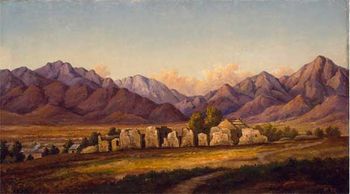San Bernardino de Sena Estancia
| This article is part of a series on the Spanish missions in California  The San Bernardino de Sena Estancia, circa 1880-1881.[1] | |
| HISTORY | |
|---|---|
| Location: | Redlands, California |
| Coordinates: | 34° 02′ 40″ N, 117° 13′ 15″ W |
| Name as Founded: | Estancia de la Misión San Gabriel, Arcángel [2] |
| English Translation: | Station of Mission San Gabriel Arcángel |
| Patron Saint: | Saint Bernardinus of Masa Marrittima, near Siena, Italy |
| Nickname: | "The Place of Plenty to Eat and Drink" [2] |
| Founding Date: | 1819 |
| Military District: | First [3][4] |
| DISPOSITION | |
| Caretaker: | County of San Bernardino |
| Current Use: | Museum |
| Web Site: | http://www.co.san-bernardino.ca.us/museum/branches/asist.htm |
The San Bernardino de Sena Estancia (also known as the San Bernardino Rancho) was established in 1819 as a ranch outpost of Mission San Gabriel Arcángel to graze cattle. The present site was established around 1830 on a portion of the Bernardino Rancho approximately one mile from the original development.
History
After secularization of the missions in 1833, the Mexican Governor of California granted the lands of the Rancho to José del Carmen Lugo, José Maria Lugo, Vincénte Lugo, and their cousin Diego Sepulveda. Included were the all of the original buildings which included a tile kiln, a lime kiln, and a grist mill. The property subsequently was sold to The Church of Jesus Christ of Latter-day Saints and occupied by Bishop Nathan C. Tenney from 1851 through 1859, when Dr. Benjamin Barton purchased it from the Mormons. Dr. Barton practiced medicine and resided on the property until 1867. Over time, materials were removed from the abandoned structure, which fell into a state of ruin.
In 1925, the County of San Bernardino acquired the property from the Barton family. All remaining historic materials were salvaged and construction of a new, six-room structure commenced in 1926 with later funding from the Works Progress Administration relief project (assisted by the San Bernardino County Historical Society). As funds weren't available to restore mere ranchos, a great deal of artistic license was taken in the design of the new, six-room structure (including exhibit space and a residence for the site manager) which replaced what was left of the original chapel building. Additionally, a freestanding campanario ("bell wall") was constructed (similar to that at the San Antonio de Pala Asistencia) even though none had existed previously. The restoration was completed in 1937 and the rebuilt structures were unveiled to the general public as "The Asistencia."
Today the facility is operated as a branch of the San Bernardino County Museum.